- Back to Home »
- Is there more to JFK's assassination?
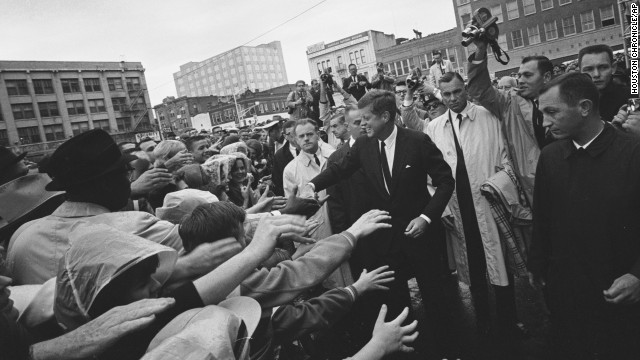 President John F. Kennedy greets supporters during his visit to Fort Worth, Texas, on Friday, November 22, 1963. This month marks 50 years since his assassination in Dallas, an event that jarred the nation and fueled a multitude of conspiracy theories about whether Kennedy was killed by a single gunman acting alone in the Texas School Book Depository. Here are some images from that fateful day as it unfolded.
President John F. Kennedy greets supporters during his visit to Fort Worth, Texas, on Friday, November 22, 1963. This month marks 50 years since his assassination in Dallas, an event that jarred the nation and fueled a multitude of conspiracy theories about whether Kennedy was killed by a single gunman acting alone in the Texas School Book Depository. Here are some images from that fateful day as it unfolded. 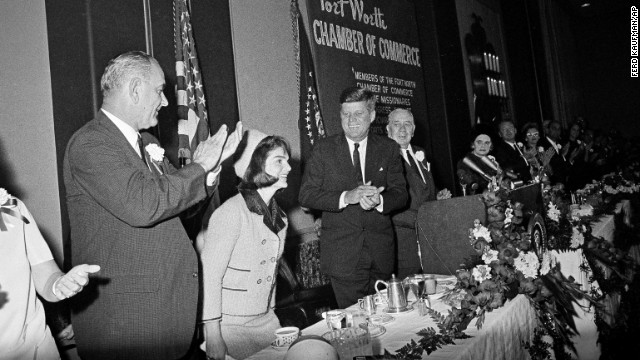 First lady Jacqueline Kennedy at a breakfast held by the Chamber of Commerce in Fort Worth with Vice President Lyndon B. Johnson, left, and Kennedy.
First lady Jacqueline Kennedy at a breakfast held by the Chamber of Commerce in Fort Worth with Vice President Lyndon B. Johnson, left, and Kennedy.  The Kennedys arrive at Love Field in Dallas on a trip to advance the upcoming 1964 campaign.
The Kennedys arrive at Love Field in Dallas on a trip to advance the upcoming 1964 campaign.  About 11:45 a.m., Texas Gov. John B. Connally Jr., waving to the crowd, and the Kennedys depart Love Field for a 10-mile tour of Dallas. The President asked about the weather earlier in the day and opted not to have a top on the limousine.
About 11:45 a.m., Texas Gov. John B. Connally Jr., waving to the crowd, and the Kennedys depart Love Field for a 10-mile tour of Dallas. The President asked about the weather earlier in the day and opted not to have a top on the limousine.  The Kennedys and Connallys leave Love Field with Secret Service Agent Bill Greer driving the presidential limousine. The motorcade is on the way to the Trade Mart, where Kennedy is to speak at a sold-out luncheon.
The Kennedys and Connallys leave Love Field with Secret Service Agent Bill Greer driving the presidential limousine. The motorcade is on the way to the Trade Mart, where Kennedy is to speak at a sold-out luncheon. 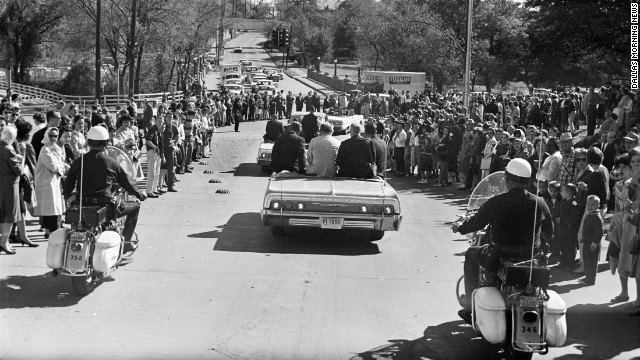 Crowds line the street as Kennedy's motorcade heads toward downtown Dallas. A group of White House staffers follows the motorcade in a bus several vehicles behind the presidential limousine.
Crowds line the street as Kennedy's motorcade heads toward downtown Dallas. A group of White House staffers follows the motorcade in a bus several vehicles behind the presidential limousine. 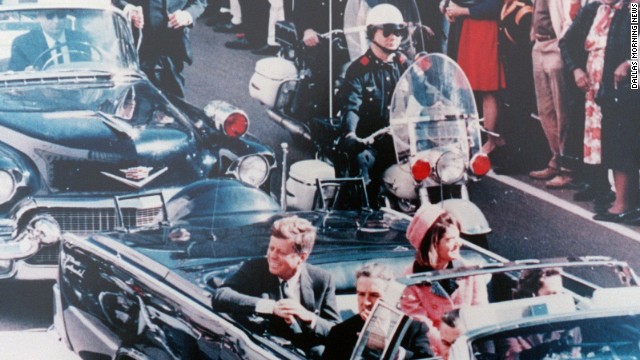 Dallas Police Officer Bobby Hargis, background, is one of four motorcycle officers assigned to Kennedy's car, which reaches Houston Street shortly before 12:30 p.m. "I thought, 'Well, we've got it made now,' " Hargis said. "And then bam! It happens."
Dallas Police Officer Bobby Hargis, background, is one of four motorcycle officers assigned to Kennedy's car, which reaches Houston Street shortly before 12:30 p.m. "I thought, 'Well, we've got it made now,' " Hargis said. "And then bam! It happens." 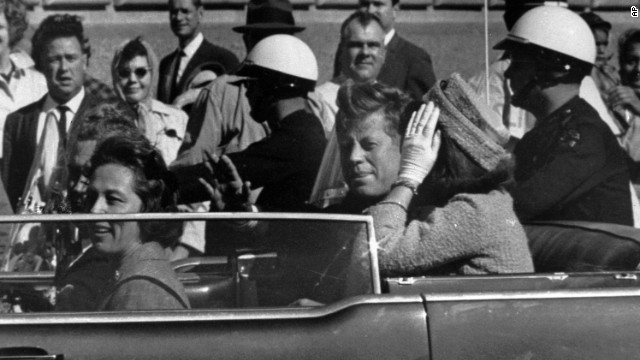 Kennedy is seen approximately one minute before he is shot.
Kennedy is seen approximately one minute before he is shot. 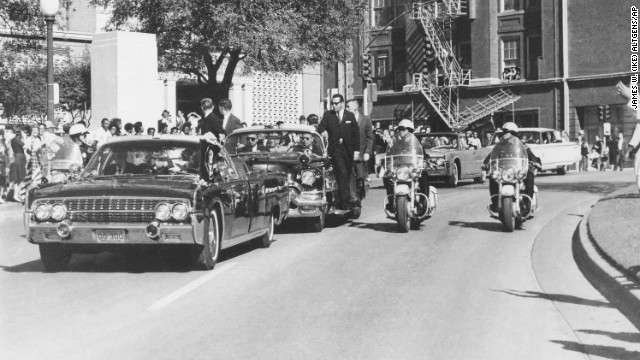 Seen through the limousine's windshield as it proceeds along Elm Street past the Texas School Book Depository, Kennedy appears to raise his hand toward his head after being shot. The first lady holds Kennedy's forearm in an effort to aid him.
Seen through the limousine's windshield as it proceeds along Elm Street past the Texas School Book Depository, Kennedy appears to raise his hand toward his head after being shot. The first lady holds Kennedy's forearm in an effort to aid him.  Kennedy slumps against his wife as the bullet strikes him in the head. Connally, who is wounded in the attack, begins to turn around just to the left of Jackie Kennedy.
Kennedy slumps against his wife as the bullet strikes him in the head. Connally, who is wounded in the attack, begins to turn around just to the left of Jackie Kennedy. 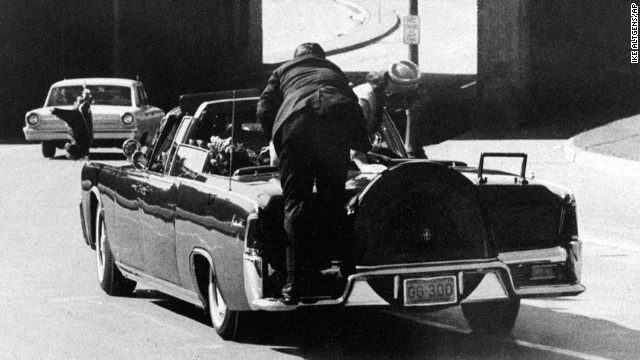 Kennedy slumps in the back seat of the car and his wife leans over to him as Secret Service Agent Clinton Hill rides on the back of the car.
Kennedy slumps in the back seat of the car and his wife leans over to him as Secret Service Agent Clinton Hill rides on the back of the car. 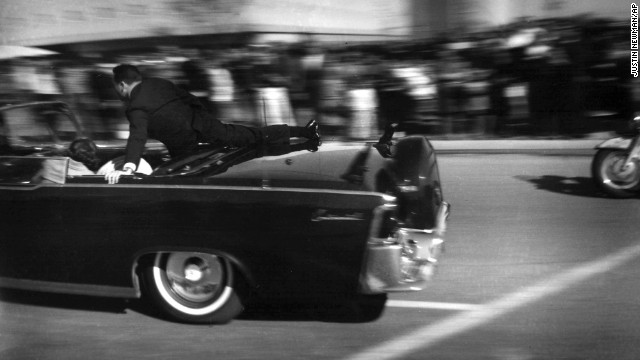 The limousine carrying the mortally wounded President races toward the hospital seconds after three shots are fired. Two bullets hit Kennedy and one hit Connally. Hill rides on the back of the car as the wives cover their stricken husbands.
The limousine carrying the mortally wounded President races toward the hospital seconds after three shots are fired. Two bullets hit Kennedy and one hit Connally. Hill rides on the back of the car as the wives cover their stricken husbands. 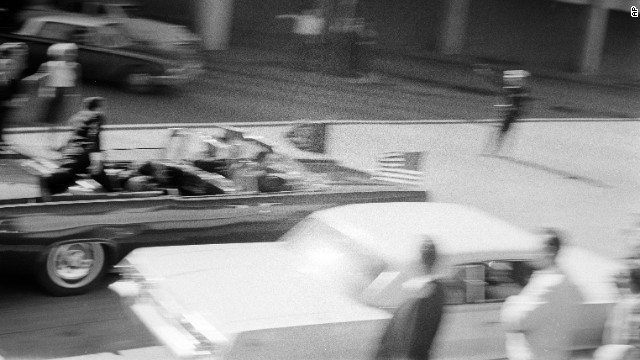 The limousine speeds along Elm Street toward the Stemmons Freeway overpass moments after shots are fired at Dealey Plaza.
The limousine speeds along Elm Street toward the Stemmons Freeway overpass moments after shots are fired at Dealey Plaza. 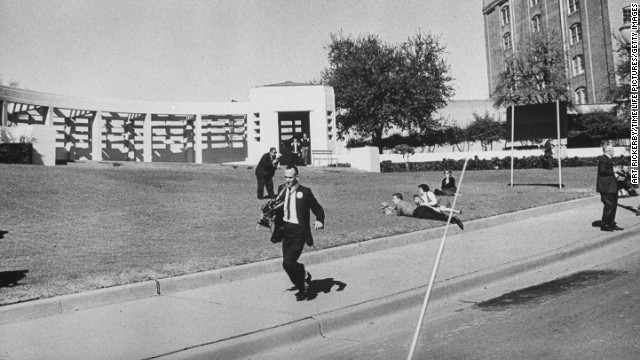 Photographers are seen running shortly after the shooting.
Photographers are seen running shortly after the shooting. 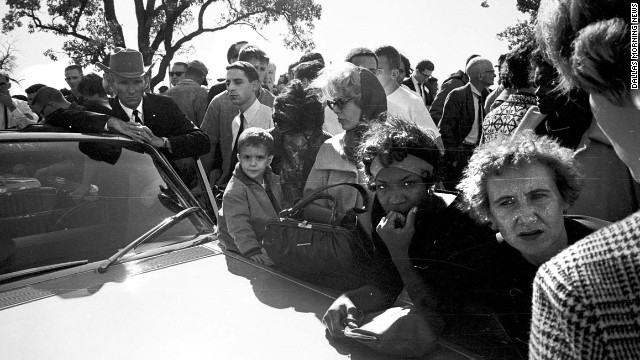 Hurchel Jacks, Vice President Johnson's driver in the motorcade, listens with others to news accounts on the car radio outside the Parkland Hospital emergency entrance. After the shots were fired, Jacks had rerouted the vice president's car to safety. The ABC radio network broadcast the first nationwide news bulletin reporting that shots have been fired at the Kennedy motorcade.
Hurchel Jacks, Vice President Johnson's driver in the motorcade, listens with others to news accounts on the car radio outside the Parkland Hospital emergency entrance. After the shots were fired, Jacks had rerouted the vice president's car to safety. The ABC radio network broadcast the first nationwide news bulletin reporting that shots have been fired at the Kennedy motorcade.  Before 1 p.m., Dr. Tom Shires, with Parkland public relations director Steve Landregan, rear, describes the President's wounds to the press. Four doctors worked on the stricken Kennedy in the emergency room.
Before 1 p.m., Dr. Tom Shires, with Parkland public relations director Steve Landregan, rear, describes the President's wounds to the press. Four doctors worked on the stricken Kennedy in the emergency room. 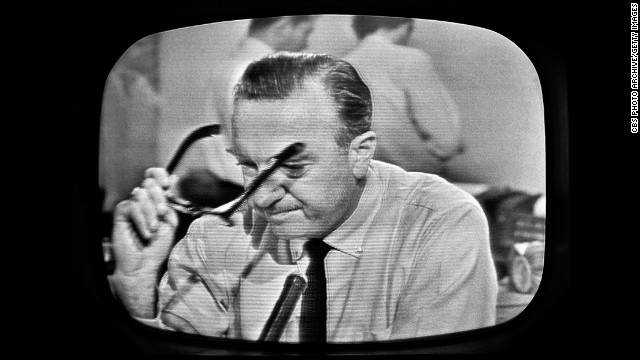 American broadcast journalist and anchorman Walter Cronkite removes his glasses and prepares to announce Kennedy's death. CBS broadcast the first nationwide TV news bulletin reporting on the shooting.
American broadcast journalist and anchorman Walter Cronkite removes his glasses and prepares to announce Kennedy's death. CBS broadcast the first nationwide TV news bulletin reporting on the shooting. 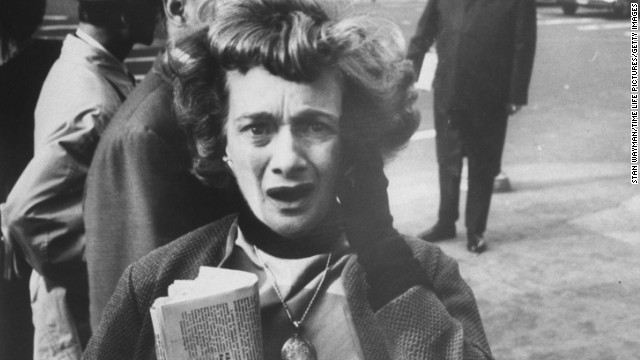 A photographer captures a New Yorker's expression of shock upon hearing the news. At 1 p.m. the 46-year-old President of the United States is declared dead, becoming the fourth U.S. president killed in office.
A photographer captures a New Yorker's expression of shock upon hearing the news. At 1 p.m. the 46-year-old President of the United States is declared dead, becoming the fourth U.S. president killed in office. 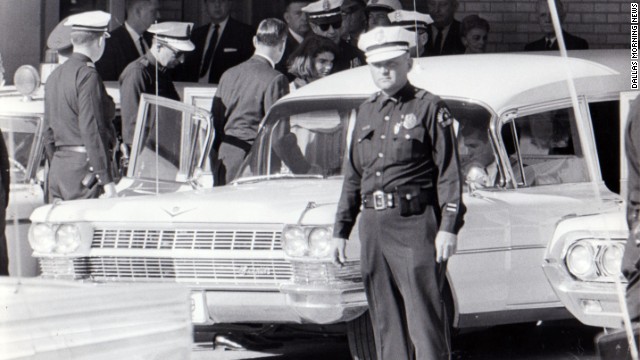 After 2 p.m., Jacqueline Kennedy leaves Parkland Hospital with her slain husband's body. She would ride in the back with the bronze casket. "I had a feeling that if somebody had literally fired a pistol in front of her face that she would just have blinked," said Dallas Police Officer James Jennings, who helped put the casket in the hearse.
After 2 p.m., Jacqueline Kennedy leaves Parkland Hospital with her slain husband's body. She would ride in the back with the bronze casket. "I had a feeling that if somebody had literally fired a pistol in front of her face that she would just have blinked," said Dallas Police Officer James Jennings, who helped put the casket in the hearse. 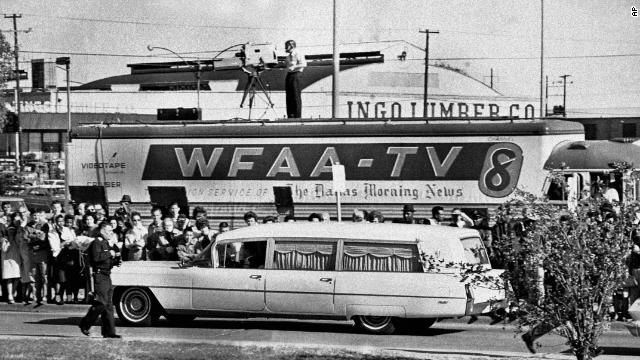 The hearse carrying Kennedy's body pulls away from Parkland Hospital en route to the airport.
The hearse carrying Kennedy's body pulls away from Parkland Hospital en route to the airport. 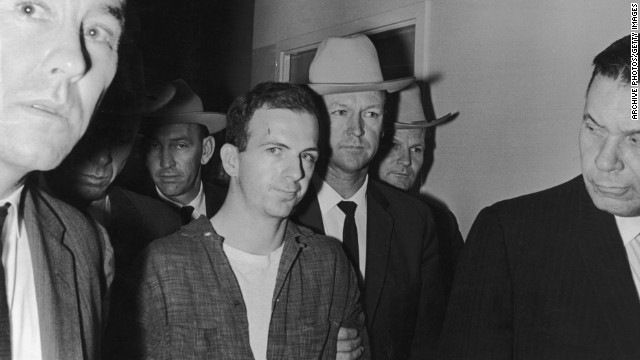 Lee Harvey Oswald, a 24-year-old ex-Marine, is arrested in the back of a movie theater where he fled after shooting Dallas Police Patrolman J.D. Tippit. That incident occurred approximately 45 minutes after the assassination.
Lee Harvey Oswald, a 24-year-old ex-Marine, is arrested in the back of a movie theater where he fled after shooting Dallas Police Patrolman J.D. Tippit. That incident occurred approximately 45 minutes after the assassination.  Vice President Lyndon Johnson takes the oath of office to become the 36th president of the United States. He is sworn in by U.S. Federal Judge Sarah T. Hughes, left, with Jacqueline Kennedy by his side on Air Force One.
Vice President Lyndon Johnson takes the oath of office to become the 36th president of the United States. He is sworn in by U.S. Federal Judge Sarah T. Hughes, left, with Jacqueline Kennedy by his side on Air Force One. 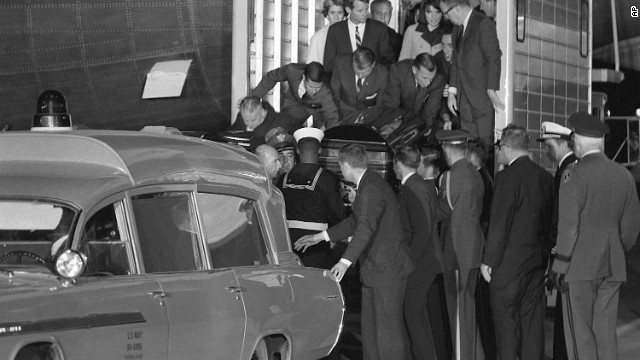 The casket containing the body of President Kennedy is moved to a Navy ambulance from the presidential plane. Jacqueline Kennedy and Attorney General Robert Kennedy stand behind on the elevator.
The casket containing the body of President Kennedy is moved to a Navy ambulance from the presidential plane. Jacqueline Kennedy and Attorney General Robert Kennedy stand behind on the elevator. 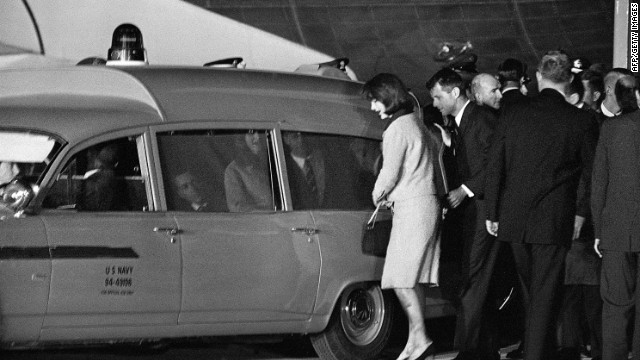 Jacqueline and Robert Kennedy get into the Navy ambulance with the president's body at Andrews Air Force Base, just outside Washington. The body of the president is taken to Bethesda Naval Hospital for an immediate autopsy.
Jacqueline and Robert Kennedy get into the Navy ambulance with the president's body at Andrews Air Force Base, just outside Washington. The body of the president is taken to Bethesda Naval Hospital for an immediate autopsy. 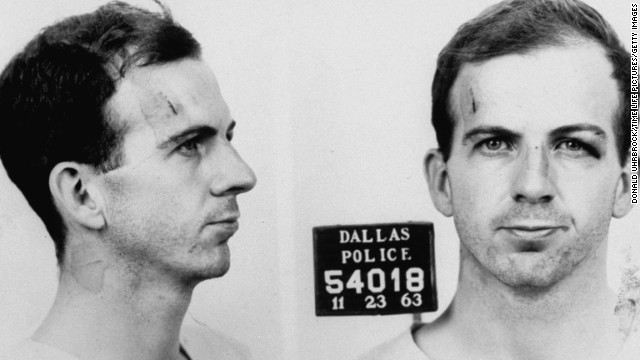 Police mug shot of Lee Harvey Oswald. He is arraigned in the slaying of Officer Tippit on November 22 and/or the murder of the president the next day. As Oswald is being transferred from the Dallas city jail to the county jail, nightclub owner Jack Ruby shoots and kills him, an event captured live on TV. Ruby is arrested immediately.
Police mug shot of Lee Harvey Oswald. He is arraigned in the slaying of Officer Tippit on November 22 and/or the murder of the president the next day. As Oswald is being transferred from the Dallas city jail to the county jail, nightclub owner Jack Ruby shoots and kills him, an event captured live on TV. Ruby is arrested immediately. 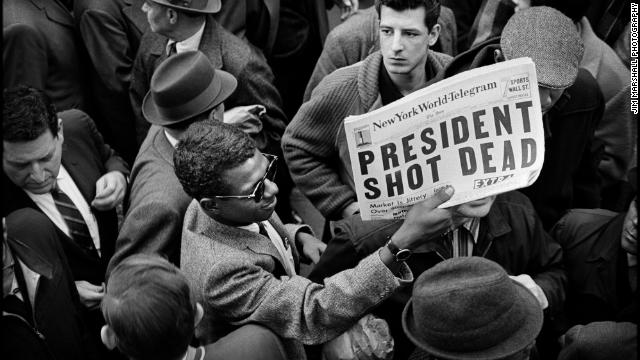 A man holds up a copy of the New York World-Telegram featuring the news of the assassination. Major television and radio networks devote continuous news coverage to the events of the day, canceling all entertainment and all commercials. Many theaters, stores and businesses, including stock exchanges and government offices, are closed.
A man holds up a copy of the New York World-Telegram featuring the news of the assassination. Major television and radio networks devote continuous news coverage to the events of the day, canceling all entertainment and all commercials. Many theaters, stores and businesses, including stock exchanges and government offices, are closed. 
1

2

3

4

5

6

7

8

9

10

11

12

13

14

15

16

17

18

19

20

21

22

23

24

25

26
- Larry Sabato: The investigation into JFK's murder was inadequate and rushed
- Sabato: Although the Warren Commission is derided, its basic conclusion is correct
- He says Lee Harvey Oswald was the killer, but was he manipulated in any way?
- Sabato: We need transparency; memos relating to the assassination must be released
Editor's note: Larry J. Sabato, author of "The Kennedy Half-Century: The Presidency, Assassination, and Lasting Legacy of John F. Kennedy," is founder and director of the Center for Politics at the University of Virginia. CNN will air the first episode of its new series "The Sixties," a two-hour special "The Assassination of JFK (1963)," on Sunday, November 17 at 9 p.m. and 11 p.m. ET.
(CNN) -- Fifty years after President John F. Kennedy's assassination, there are very few down-the-line defenders of the Warren Commission to be found. The investigation into JFK's murder was inadequate, rushed and manipulated by powerful officials.
Just consider a few of the commission's flaws.
-- President Lyndon Johnson and FBI Director J. Edgar Hoover had all but decided what the report would say -- that Lee Harvey Oswald was the lone gunman with no conspiracy -- within 48 hours of the shooting.

-- The report was issued on a political timetable. LBJ wanted it out well before his election in November 1964.
-- The FBI was less interested in the full truth and more determined to avoid blame for misreading Oswald's violent character. Hoover later admitted: "We failed in carrying through some of the most salient aspects of the Oswald investigation. It ought to be a lesson to all."
-- Far worse was the behavior of the CIA, which coached some witnesses, hid others and withheld important information. The agency never told the commission it had been keeping tabs on Oswald or why. To this day, the CIA says it did not have a relationship with Oswald and that it is not withholding anything important about the assassination from the public.
-- Even more suspiciously, the CIA maintained its subterfuge and continued to lie to yet another official JFK investigation in the 1970s, this one run by the U.S. House of Representatives. It was a chance to come clean, with lesser consequences, and the CIA didn't take it. The director of that study, Robert Blakey, now denounces the CIA and says he doesn't believe anything the agency told him and his panel.
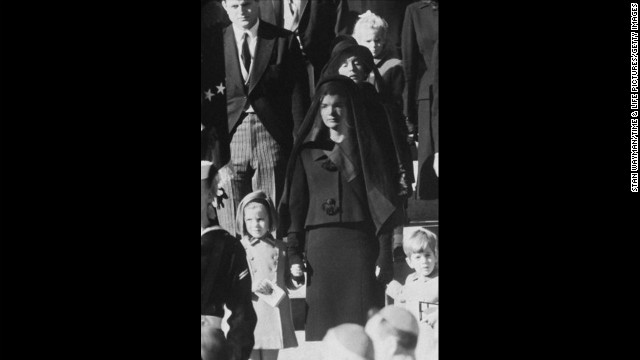 On November 22, 1963, President John F. Kennedy was assassinated while in a presidential motorcade in Dallas. Pictured, Kennedy's widow, Jacqueline Kennedy, children, Caroline and John, and mother, Rose Kennedy, behind, wait outside St. Matthew's Cathedral for the procession to the cemetery during his funeral on November 25.
On November 22, 1963, President John F. Kennedy was assassinated while in a presidential motorcade in Dallas. Pictured, Kennedy's widow, Jacqueline Kennedy, children, Caroline and John, and mother, Rose Kennedy, behind, wait outside St. Matthew's Cathedral for the procession to the cemetery during his funeral on November 25. 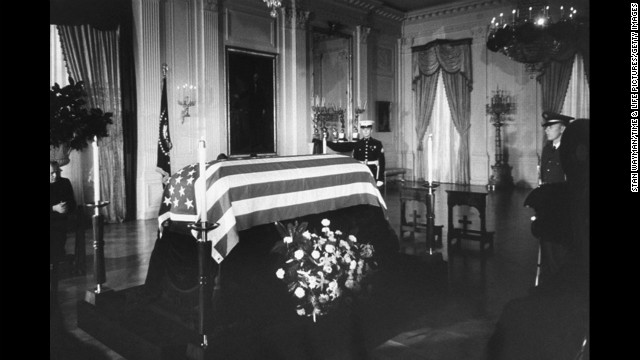 On November 22, 1963, President John F. Kennedy was assassinated while in a presidential motorcade in Dallas. Pictured, Kennedy's widow, Jacqueline Kennedy, children, Caroline and John, and mother, Rose Kennedy, behind, wait outside St. Matthew's Cathedral for the procession to the cemetery during his funeral on November 25.
On November 22, 1963, President John F. Kennedy was assassinated while in a presidential motorcade in Dallas. Pictured, Kennedy's widow, Jacqueline Kennedy, children, Caroline and John, and mother, Rose Kennedy, behind, wait outside St. Matthew's Cathedral for the procession to the cemetery during his funeral on November 25. 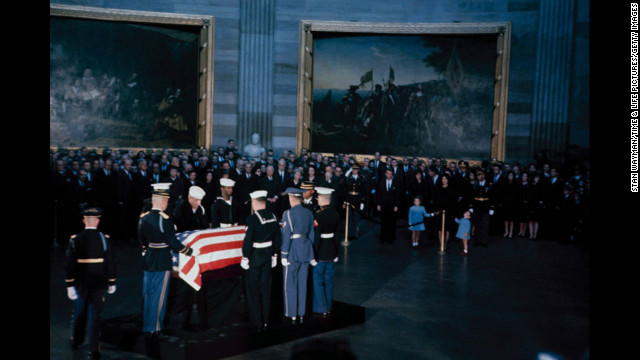 Kennedy's flag-draped casket lies in state in Washington.
Kennedy's flag-draped casket lies in state in Washington. 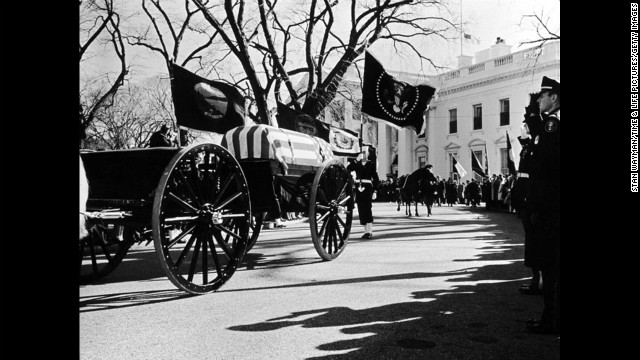 John F. Kennedy's flag-draped casket lies in state in Washington.
John F. Kennedy's flag-draped casket lies in state in Washington. 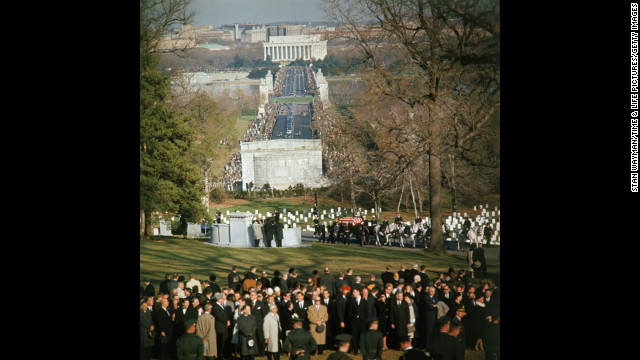 A horse-drawn caisson bears the body of President John F. Kennedy into Arlington National Cemetery.
A horse-drawn caisson bears the body of President John F. Kennedy into Arlington National Cemetery. 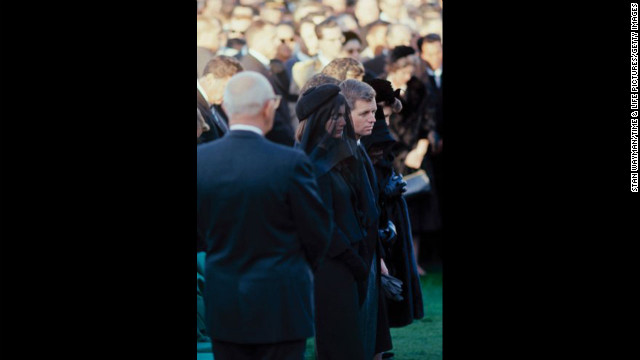 John F. Kennedy's widow, Jacqueline Kennedy, and brother Robert Kennedy attend his funeral at Arlington National Cemetery. See the complete gallery of photos at LIFE.com.
John F. Kennedy's widow, Jacqueline Kennedy, and brother Robert Kennedy attend his funeral at Arlington National Cemetery. See the complete gallery of photos at LIFE.com.  Photos: John F. Kennedy's funeral
Photos: John F. Kennedy's funeral  Nation mourns at JFK's funeral
Nation mourns at JFK's funeral  1961: JFK's famous inaugural address
1961: JFK's famous inaugural address 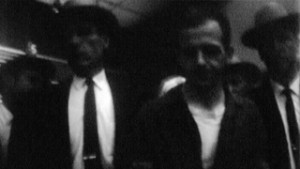 Lee Harvey Oswald speaks to the press
Lee Harvey Oswald speaks to the press -- Both the CIA and the FBI failed to inform the commission about their various arrangements with the Mafia, another prime suspect in Kennedy's killing. They considerably underplayed Oswald killer Jack Ruby's organized crime ties. "The evidence does not establish a significant link," the commission asserted, but in fact, Ruby was in frequent contact with mobsters.
-- A surprising number of first-hand, close-in witnesses from Dealey Plaza on November 22 were never interviewed by the commission. These people had useful information to impart. I interviewed some of them, still living after the passage of five decades, and to this day they cannot understand why the commission was uninterested.
-- The commission dismissed or ignored some compelling testimony that contradicted its preferred findings.
Thus, the Warren Commission failed to find the full truth when the trail was hot, and when most Americans would have welcomed the most thorough possible investigation, even if the process was lengthy and costly. We can never recapture that moment, or reel in the cynicism that has developed because of its inadequacies.
If we could go back in time, maybe it would be possible to figure out why the CIA was so interested in Oswald or why the FBI was so responsive when Oswald demanded to see its agents while he was in a New Orleans jail in August 1963. (Ask yourself whether the FBI would come running if you summoned it while incarcerated on a minor charge.)
It would also be useful to know what really happened when Oswald visited the Cuban and Soviet embassies in Mexico City just two months before the assassination.
With this extensive a list of shortfalls, is it any wonder the Warren Commission is widely derided? So, it may come as a surprise that, despite everything, a large part of the commission's basic conclusion turns out to be correct.
Lee Harvey Oswald almost certainly was the man who killed President Kennedy. Under an alias, he had mail-ordered an Italian rifle from Chicago. The Dallas police found photos of Oswald holding a rifle, taken by his wife. Contrary to theories that float on the Internet, the pictures were not doctored.
Oswald had demonstrated violent tendencies by attempting to kill Major Gen. Edwin Walker in April 1963. Oswald's wife has recalled that he had also made a veiled threat against former vice president Richard Nixon.
Oswald's rifle was found, and his palm print was identified on a box inside the sniper's nest on the sixth floor of the Texas School Book Depository. The trajectory of the bullets fired from the open window essentially matches the wounds suffered by both President Kennedy and Texas Gov. John Connally, who was sitting a few inches lower and to the left of JFK in the jump seat in front of the president.
After Oswald's first bullet missed the car entirely, the so-called "magic bullet" that struck JFK in the back was perfectly aligned to do substantial damage to Connally's body. And the final bullet that hit JFK in the head came from up and behind him, not the front. There is a reasonable physiological explanation for the actions of the president's body in the car once his skull was blown apart.
Two Dallas reporters in the motorcade saw a rifle protruding from the window (though not Oswald himself, who was shielded). A depository employee watching the motorcade from the fifth floor window below the one with the gun testified that he heard the sound of a fast-moving bolt action rifle and brass cartridges falling on the floorboards just above his head. A homemade paper bag was left on the sixth floor, and the employee who gave Oswald a ride to the depository on the morning of November 22 testified that Oswald was carrying a parcel wrapped in brown paper that Oswald claimed was "curtain rods," but which just as easily could have been a disassembled rifle.
Oswald was the only employee found missing from the depository a short while after the assassination. Most of the ballistics and eyewitness evidence suggests that Oswald shot Officer J.D. Tippit later that afternoon -- hardly the deed of an innocent person. Oswald tried to shoot another officer at the Texas Theatre when he was captured a little while later, shouting, "It's all over now."
Oswald was a deeply troubled man, a castaway who never fit well anywhere and could get along with few. He was someone yearning to be great but without the wherewithal to achieve it. At the end of his rope on November 22, 1963, Oswald had left his wedding ring and most of his money behind for his wife Marina and his two young daughters. He grabbed his rifle and planned to go out in a blaze of history-making glory by striking out at the ultimate symbol of power and success, a president who by pure chance would be passing by his place of low-level employment. Had Oswald not been killed by Jack Ruby, we probably would have learned as much in a few weeks or months.
Yet the story doesn't necessarily end with Oswald. There is no question that many powerful individuals and groups, some with whom Oswald had personal association, possessed the means, motive and opportunity to kill President Kennedy.
Was Oswald encouraged or manipulated in any way? Did anyone overtly or covertly aid him? After the assassination, were the FBI and especially the CIA simply trying to cover up for their incompetence in missing Oswald's nature and intent, or were there more sinister motives?
So much time has passed that we may never know, but our one chance to discover more is in the release of thousands of additional pages of memos relating to the assassination, including hundreds of items from the CIA.
After 50 years, it is absurd that anything is still hidden. Supposedly, the documents will be made public in a few years, but there is no guarantee. The Assassination Records Collection Act, signed by President George H.W. Bush in 1992, requires that all remaining documents about the Kennedy assassination be released by October 26, 2017.
The next president will rule on any requests from the CIA and other agencies that materials be withheld or redacted after 2017. Under the law, the president can do so only if there is identifiable harm to our national security that outweighs the public interest in disclosure. But it's possible the CIA could succeed in having some memos held back and others substantially redacted.
The right time came long ago for complete disclosure. Transparency cannot bring President Kennedy back, but at long last it can help America to come to terms fully with November 22, 1963 -- and perhaps to prevent similar events in our future.
Follow us on Twitter @CNNOpinion
Join us on Facebook/CNNOpinion
The opinions expressed in this commentary are solely those of Larry J. Sabato.







